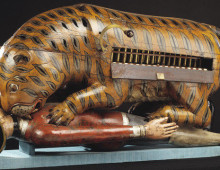Tagged with Work and labour
Resource : The factory child’s trouble – sampler
This is a sampler that records the sufferings of a child, working in one of the many textile mills in Salford (Greater Manchester). It was sewn by Elizabeth Hodgates who was 12 years old in 1833 and reminds us of the terrible working conditions for children, women and men during the industrial revolution.
Resource : Luddite ticket
In the early 1700s, work in the textile industry was mainly hand-operated and undertaken by people skilled in crafts – such as weaving and knitting. But innovations in steam power and the design of machinery in the late 18th and early 19th century transformed manufacturing and the way people worked. Much of the new labour could be undertaken by unskilled workers in factories away from the household, quicker than ever before and for a fraction of the price. Skilled textile workers, who found their livelihoods threatened by new, labour-saving technology, responded witha series of violent protests. They became known as the Luddites.
Resource : Textile sample books
Cotton was one of the latest textile fibres to be introduced to Britain as a raw material within a manufacturing system, but between the eighteenth and nineteenth centuries it rose to prominence as a cornerstone of the British economy. Cotton manufacture stimulated industrialisation, global commercial influence, and new communities of labour. This is one of five early sample books illustrating the cotton and calico designs produced by the textile industry in Salford between 1769 and 1851.
Resource : Crompton’s spinning mule
The spinning mule was invented by Samuel Crompton in 1779. It revolutionised textile production by vastly increasing the amount of cotton that could be spun at any one time. But this also meant textile manufacturers no longer needed to pay individual spinners to create spindles (wooden rods) wound with cotton thread, as just one operator could now use the machine to spin hundreds of spindles at once.


